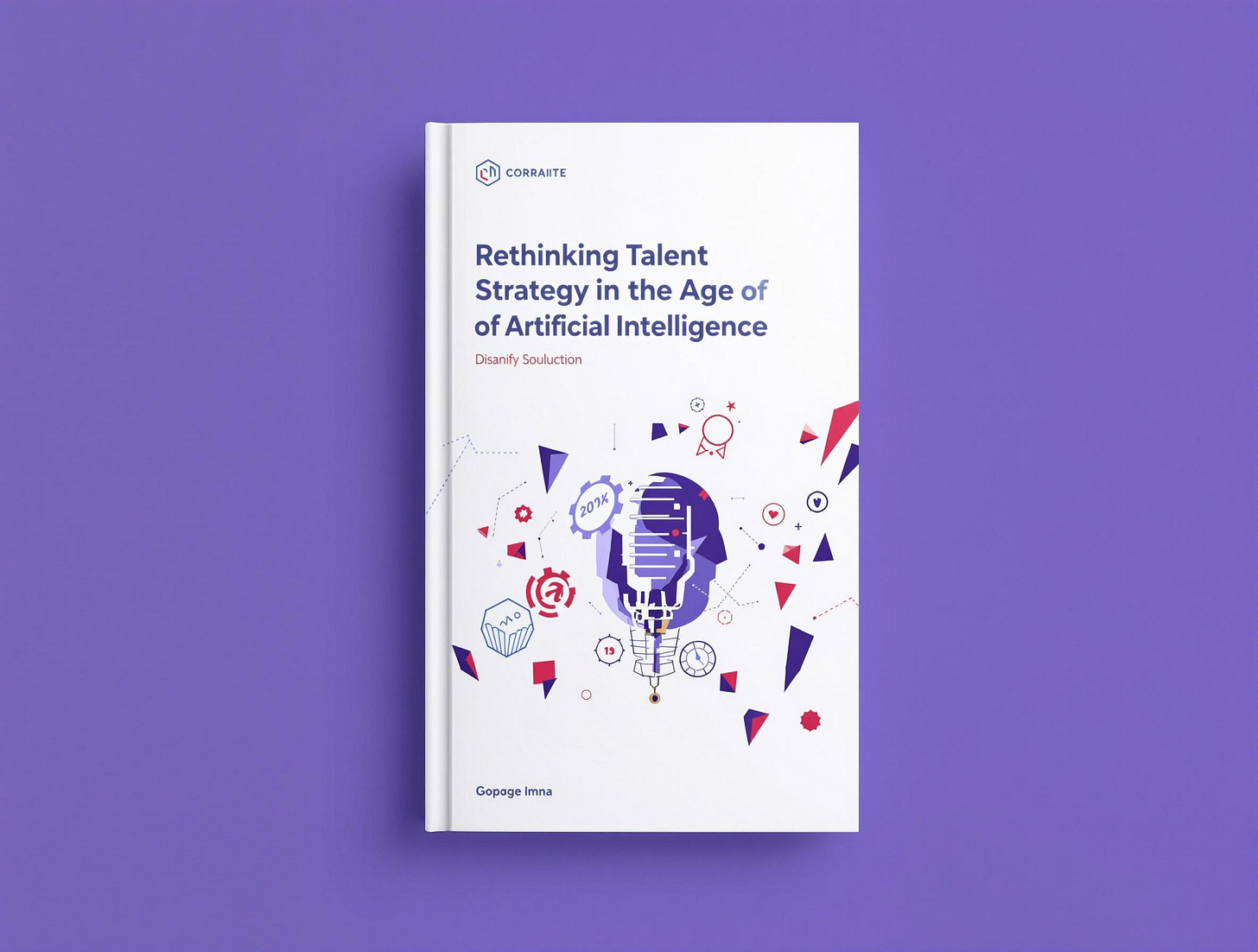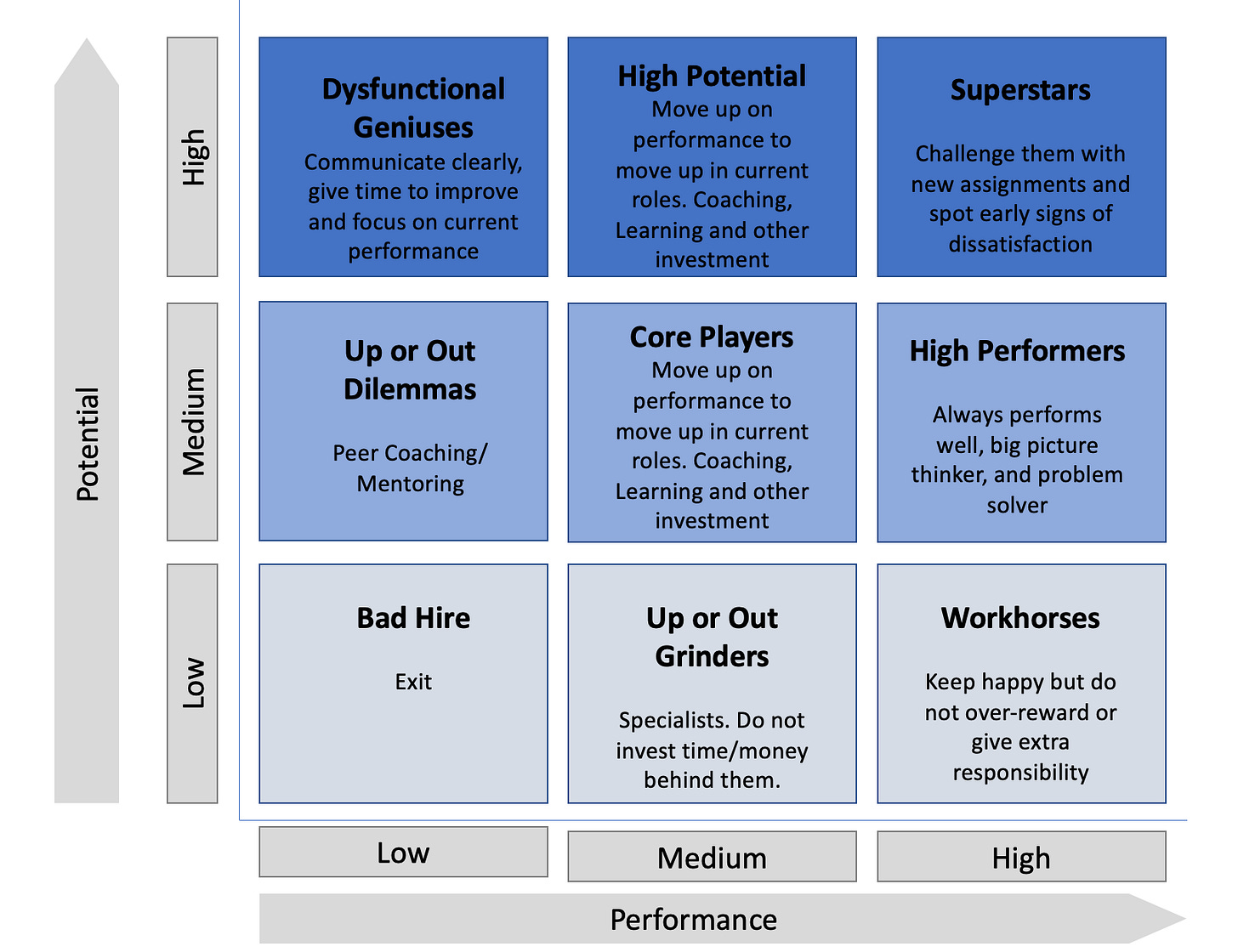The traditional 9-box talent management framework has been a cornerstone of HR strategy for decades (sure there are lovers and haters, like for every framework). But as AI reshapes organizational capabilities, it's time to reimagine how we think about potential, performance, and resource allocation.
Let's dive deep into how AI is disrupting this classical framework and what it means for the future of talent management.
The Classic Framework: A Quick Primer
For the uninitiated, the 9-box grid maps employees across two axes: performance (low to high) and potential (low to high). This creates nine boxes, each representing different combinations of current delivery and future capability. Traditionally, it looks something like this:
While it’s not perfect it does give a starting point and forces managers to think through the capabilities of their teams. There is also a recommended reward mix (a.k.a. if you had $100 how would you split it between your employees in 9 boxes?) but I am not going to into the specifics of the recommended split, at least not today.
The AI Disruption: Which Boxes Are At Risk?
Here's where things get interesting. AI isn't just another tool – it's a fundamental reshape of what we consider "performance" and "potential." Let's break down how AI might impact each box:
Box 1 & 2 : The First to Go?
These roles are prime candidates for AI automation. Tasks that humans consistently struggle with or perform inconsistently are exactly where AI shines. Think data entry, basic customer service, and routine administrative work.
The future of low-performance roles isn't about improvement – it's about replacement.
Yep, you read it right and that’s what is happening right now at a lot of places.
Box 4 & 7 (High Performance, Low Potential):
Here's where it gets controversial. These reliable workhorses of organizations, especially in technical roles, face a unique threat. While they excel at their current jobs, their limited potential for growth makes them vulnerable to increasingly sophisticated AI systems.
The technical expert who's mastered a specific domain but shows no interest in broader organizational impact might find their expertise encoded into an AI system that never tires and can be replicated infinitely.
Box 5 (The Middle):
The traditional "solid citizens" of organizations face a squeeze from both ends. They need to either level up to become more strategic or risk being replaced by AI systems that can handle middle-complexity tasks with greater efficiency.
Box 3, 6, & 9 (High Potential):
These boxes become even more valuable in the AI era. The ability to learn, adapt, and grow becomes paramount as organizations need people who can work alongside AI, identify new opportunities, and reshape processes.
Rethinking Resource Allocation
Traditionally, compensation and development dollars followed a predictable pattern:
Box 9: 20% above market
Box 8: 15% above market
Box 6: 10% above market
Box 5: At market
Lower boxes: Below market
But this model needs a dramatic rethink in the AI era. Here's why:
The Skills Premium Shift
The premium for technical skills alone (Box 7) will decrease as AI becomes more capable. Instead, the premium shifts to those who can:
Effectively prompt and direct AI systems
Identify new applications for AI capabilities
Manage the human-AI interface
Drive organizational change and adoption
The Development Dollar Dilemma
Traditional development budgets focused on technical skills and leadership capabilities. In the AI era, organizations need to consider:
AI literacy training across all boxes
Reskilling budgets for boxes most at risk
Innovation capabilities for high-potential boxes
Human-AI collaboration skills
The New Performance Metrics
We need to rethink what "high performance" means when AI can handle many traditional metrics. New considerations might include:
Ability to augment AI capabilities
Innovation in AI application
Change management effectiveness
Strategic thinking in an AI context
Controversial Take: "Organizations should consider investing heavily in Box 3 (High Potential, Low Performance) talents who show strong AI aptitude, even at the expense of current high performers who resist AI adoption."
The Future of Box Management
Here's what organizations need to consider:
Dynamic Box Movement
The traditional annual review cycle is too slow. Organizations need real-time assessment of how employees adapt to and leverage AI capabilities. Box placement should be more fluid and responsive to technological change.New Box Definitions
We need to add an "AI Adaptability" dimension to our assessment. High potential might need to be redefined as "ability to identify and leverage AI opportunities" rather than traditional leadership capabilities.Resource Allocation Revolution
Instead of the traditional pattern, consider:
Higher investments in rapid reskilling programs
Premium compensation for AI integration skills
Reduced investment in roles likely to be automated
New incentives for AI innovation and adoption
Provocative Questions for Leaders:
Should organizations maintain separate 9-box grids for technical and AI-augmented roles? (or non 9-box if you don’t like the boxes)
How do we value and reward employees who effectively make themselves redundant through AI implementation?
Should we create new boxes specifically for AI-human hybrid roles?
How do we handle the ethical implications of essentially using the 9-box grid as a tool for identifying automation targets?
Looking Ahead
The 9-box grid isn't dead – but it needs a serious upgrade. Organizations that adapt this framework for the AI era will have a powerful tool for:
Identifying automation opportunities
Developing future-proof talent
Allocating resources effectively
Building AI-ready leadership pipelines
The future of talent management isn't about choosing between humans and AI – it's about creating a framework that maximizes the potential of both.
The Challenge Ahead
The biggest challenge for organizations isn't just implementing AI – it's reimagining talent management frameworks that have served us well but need evolution. The 9-box grid can still be valuable, but only if we're willing to:
Redefine potential and performance
Rethink resource allocation
Rebuild development pathways
Reimagine career progression
The organizations that get this right will have a significant competitive advantage in attracting, developing, and retaining the talent needed for an AI-augmented future.
What's your take? How is your organization adapting talent management frameworks for the AI era? Let's discuss in the comments.
P.S. The book ends here :)





